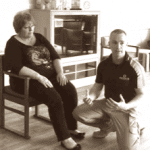Where an older person in care is soiled and needs the attention of care staff to get cleaned up, but resists verbally and physically (sometimes combatively) their efforts to do so, then we believe it is important that every step of the process to manage this scenario is managed in a clear, ordered and auditable way. As previously discussed on our blog, we believe that this kind of incident is reasonably frequent in some services and, as a foreseeable scenario which carries high risk, it should be properly risk assessed and is likely to need a formal, written procedure and protocol for the times when it is invoked.
The physical handling of any load or person is regulated under the Manual Handling Regulations 1992.
The Regulations are made under the Health and Safety at Work etc Act 1974. They implement European Directive 90/269/EEC on the manual handling of all loads [including human patients- see Regulation 2(1)] supplement the general duties placed on employers and others by the Health and Safety at Work etc Act 1974 and the broad requirements of the Management of Health and Safety at Work Regulations 1999.
Physical restraint of an uncooperative, aggressive and / or violent subject heightens the risk of injuries being caused due to the volatile nature and reason for the intervention. The injured person does not always make a full recovery; the result of which can be physical impairment or even permanent disability.
The Regulations and Associated Guidance paragraphs establish a clear hierarchy of measures:
1: Avoid hazardous manual handling operations so far as is reasonably practicable. This may be done by redesigning the task to avoid moving the load or by automating or mechanising the process.
2: Make a suitable and sufficient assessment of any hazardous manual handling operations that cannot be avoided.
3: Reduce the risk of injury from those operations so far as is reasonably practicable. Particular consideration should be given to the provision of mechanical assistance. Where this is not reasonably practicable then other improvements to the task, the load and the working environment should be explored.
For this reason, any staff member who is tasked with, for example, cleaning a resident who is resisting efforts at personal care, is engaged in a manual handling activity. It can further be argued that at some point that task becomes one which can not be avoided. The Manual Handling Regulations require that the procedure they are using to carry out that task should be assessed in such a way as to reduce the risk.
We are unsure at present whether staff being asked to carry out some tasks are receiving the benefit of such assessments.
For example, the member of night-shift staff who is tasked with cleaning a resident who is known to resist or refuse efforts to assist them with personal hygiene. How are lone workers on the night-shift supported in carrying out this task safely?
Further to this issue, are staff being given full and complete procedures by competent staff when they are asked to enter a bedroom in a team of three people to clean someone who is resisting their efforts?
—————————————
Gerard O’Dea is a conflict management, personal safety and physical interventions training consultant. He is the training director for Dynamis, a specialist provider of personal safety and violence management programmes and the European Adviser for ‘Verbal Defense and Influence’, a global programme which addresses the spectrum of human conflict. www.dynamis.training



